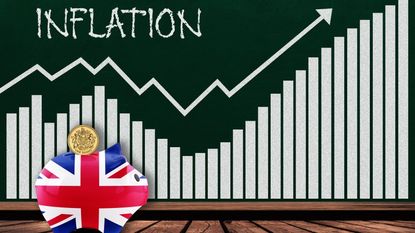CPI inflation vs RPI inflation: what’s the difference?
We’ve been hearing a lot about CPI inflation recently, but what is this metric and why is it different to RPI inflation?


Arguably, inflation has been one of the biggest challenges for business and the economy this year. CPI inflation has reached multi-decade highs, as the world struggles to recover from the effects of the pandemic. And RPI inflation is even higher, although it’s not talked about as much.
Energy and food prices started rising as demand rose after the lockdowns. This was compounded by supply chain blockages. Reduced airline capacity led to higher redirected cargo to the sea, resulting in higher freight rates. Labour shortages because of sickness, isolation and persistent Covid-19 restrictions in key manufacturing locations like China, have slowed down the supply chain further.
That’s without mentioning Russia’s war on Ukraine, which added to supply challenges for both food and energy.
Subscribe to MoneyWeek
Subscribe to MoneyWeek today and get your first six magazine issues absolutely FREE

Sign up to Money Morning
Don't miss the latest investment and personal finances news, market analysis, plus money-saving tips with our free twice-daily newsletter
Don't miss the latest investment and personal finances news, market analysis, plus money-saving tips with our free twice-daily newsletter
CPI is high, RPI is even higher
As energy and food prices have spiked, a cost-of-living crisis has ensued, with prices rising faster than spendable income. In other words, consumers can’t afford the same amount of goods or services as they were able to a year ago.
In the UK, the headline figure of inflation based on the consumer price index (CPI) came in at 10.7% in November compared with the same month a year ago.
If this number isn’t eye-popping enough already, consider inflation based on the retail price index (RPI) which is at an even higher 14%.
Both numbers are high, for sure. But the fact that RPI inflation is almost three percentage points above CPI is notable.
What is RPI inflation?
RPI is the original consumer price inflation measure. In fact, from its first official publication in 1956 until 1996 when the CPI was introduced, RPI was the only measure of its kind available for the UK economy.
The goal of RPI is to assess inflation faced by the “typical household”. To this extent, it excludes the top 4% of households by income as well as pensioner households, who get at least 75% of their income as benefits.
George Buckley, chief UK and euro area economist at Nomura, points out that it’s “being phased out”, in favour of the CPI.
What is CPI inflation?
The CPI is now the UK’s official inflation measure. There are good reasons for this.
As Buckley adds “CPI is both the Bank of England’s target inflation rate and is also comparable to euro area figures”. In fact, the need for a consistent inflation measure across Europe was one of the reasons the CPI was first developed.
EU inflation for October, for instance, came in at 11.5%, which tells us instantly that at least in the last month, the UK was slightly better off. If instead, we looked at RPI inflation, UK price rises would look much worse than those for the EU.
That said, the fact remains that CPI inflation is still far higher than the Bank of England’s target rate of 2%. The difference between the two indicates that interest rates in the UK will keep rising, for now, just to get runaway price increases under check.
What is CPIH inflation?
Interestingly, though, the ONS considers the CPIH as its lead inflation index, calling it “the most comprehensive measure of inflation”. This is because it includes owner-occupiers’ housing costs (OOH), which are excluded from the CPI. The OOH component includes the costs of owning, maintaining and living in a home.
It came in lower than the CPI inflation index at 9.6% in October, and in fact, has consistently been lower over the past year because of subdued OOH inflation. However, Sanjay Raja, chief UK economist at Deutsche Bank points out “given the complexity in accurately measuring ‘housing’ costs, we see CPI as the more trusted measure of inflation”.
It’s worth noting that RPI also includes housing costs, which leads to the next obvious question: What then is the difference between the CPIH and the RPI?
What’s the difference between CPIH, CPI and RPI inflation?
Both CPI and CPIH are calculated in the same way, with the only difference being the exclusion of OOH from CPI.
Both, however, differ from RPI in a number of ways.
One of them is coverage. As mentioned earlier, the RPI is an inflation measure for the average household in the UK. The CPI measures, however, also cover institutional households, which includes care homes, boarding schools and other student accommodation.
There is also some difference in the expenses considered. Importantly, RPI covers mortgage interest payments, which are excluded from the CPI measures. The CPI metrics, in turn, consider items such as university accommodation fees, foreign students’ university tuition fees and unit trust and stock brokers’ charges, which aren’t part of RPI.
The RPI is also calculated differently. The weights for various prices are derived from the annual Living Costs and Food Survey (LCF). The prices of items considered are multiplied by the weights. The arithmetic mean of these weighted prices results in the RPI.
It does get a bit more complex than this, in that different formulas are used to determine the mean. But for the purpose of understanding the difference between RPI and CPI calculation, the key distinction is the kind of mean used.
The geometric mean is used to calculate the CPI and CPIH. Unlike the arithmetic mean, it multiplies all the weighted prices instead of adding them. Here the weights are derived from the national accounts data, not the LCF. This resulting product is then whittled down to the root value. The root value is essentially the number that would give the product if it were multiplied by itself as many times as the number of price items considered.
Why is RPI inflation higher than CPI inflation?
The differences in methodology reveal why the RPI is so much higher than both the CPI measures.
The inclusion of housing-related prices in the RPI, for one, has pushed it up. But Raja highlights “This should unwind as mortgage rates adjust following the mini-Budget boom in mortgage rates. And house prices are already on the decline, which will further narrow the CPI-RPI wedge over the coming quarters”.
It’s still unlikely to fall below the CPI any time soon, purely because the arithmetic mean is always either bigger than or equal to the geometric mean. The “formula” effect, as it’s called, makes it comparatively elevated, which is a bit of a relief going by how high it is.
That said, CPI inflation is finally expected to fall to the Bank of England’s target rate of 2% only by late 2024, as both Buckley and Raja agree.
Manika Premsingh is a macroeconomist and a stock analyst. Her investment research and writing is published on Seeking Alpha and in the past on The Motley Fool. She has also extensively provided research on both the economy and the stock markets for companies in investment management, stock broking and investment banking.
She is also a public speaker, having shared her views on the economy at various international forums. She has also been quoted for her views on the economy over the years in leading international publications.
Manika has a masters in economics and has done a certification programme in entrepreneurship, for which she received the Goldman Sachs 10,000 Women scholarship. Most recently she has completed a short course in sustainable development and is pursuing a certification in impact measurement & management for sustainable development goals.
-
-
 Investment trust discounts hit 2008 levels. Here’s how to profit
Investment trust discounts hit 2008 levels. Here’s how to profitInvestment trust discounts have risen to levels not seen since 2008, here are three trusts looking to buy to profit.
By Rupert Hargreaves Published
-
 A luxury stock to buy at a high street price
A luxury stock to buy at a high street priceInvestors wrongly consider Watches of Switzerland a high-street outlet.
By Dr Matthew Partridge Published
-
 UK wage growth hits a record high
UK wage growth hits a record highStubborn inflation fuels wage growth, hitting a 20-year record high. But unemployment jumps
By Vaishali Varu Published
-
 UK inflation remains at 8.7% ‒ what it means for your money
UK inflation remains at 8.7% ‒ what it means for your moneyInflation was unmoved at 8.7% in the 12 months to May. What does this ‘sticky’ rate of inflation mean for your money?
By John Fitzsimons Published
-
 VICE bankruptcy: how did it happen?
VICE bankruptcy: how did it happen?Was the VICE bankruptcy inevitable? We look into how the once multibillion-dollar came crashing down.
By Jane Lewis Published
-
 Would a food price cap actually work?
Would a food price cap actually work?Analysis The government is discussing plans to cap the prices of essentials. But could this intervention do more harm than good?
By Nicole García Mérida Published
-
 What is Warren Buffett’s net wealth?
What is Warren Buffett’s net wealth?Features Warren Buffett is one of the world’s richest people. But how did he make his money?
By Jacob Wolinsky Last updated
-
 What is Rihanna's net worth?
What is Rihanna's net worth?Features Rihanna became the youngest self-made billionaire in 2022. Here’s how she made her money.
By Jacob Wolinsky Published
-
 UK inflation slides to 8.7% - what does it mean for your money?
UK inflation slides to 8.7% - what does it mean for your money?News Inflation has dropped below 10% for the first time in months, but with food prices at a 45-year high, is this good news and what does it mean for your money?
By Tom Higgins Published
-
 What is Bill Gates's net worth?
What is Bill Gates's net worth?Features Bill Gates is one of the world’s richest people, but how did he make his money?
By Jacob Wolinsky Last updated









